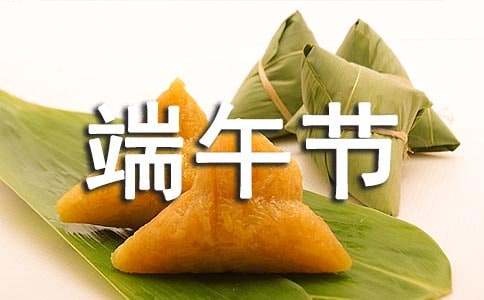- 相關推薦
端午節的由來和風俗英文版
農歷五月初五端午節,這可是老祖宗幾千年流傳下來的啊,而且是僅次于春節和中秋節的三大傳統節日。這個重大節日包含有很重要的紀念意義,舉國同慶,萬眾歡騰,意義非凡。下面是小編為大家收集的端午節的由來和風俗英文版,歡迎閱讀與收藏。

端午節的由來和風俗英文介紹
Dragon Boat Festival
中國端午節
Dragon Boat Festival (Duanwu Festival) is on the fifth day of the fifth lunar(農歷的)month every year. It is one of the most important traditional(傳統的) festivals in China.
端午節是在每年農歷五月初五。它是中國最重要的傳統節日之一。
Legends(傳說) about Dragon Boat Festival
端午節的傳說
There are many different legends about the festival, but the most famous one is about Qu Yuan, a patriotic(愛國的) poet in ancient China.
關于端午節的傳說有很多。最著名的一個傳說是和屈原——中國古代的一位愛國詩人有關的。
Customs(習俗) about Dragon Boat Festival
端午節的習俗
1.Eating Zongzi
吃粽子
Zongzi is a kind of food made with sticky rice(糯米) and is wrapped(包裹) withreed(蘆葦) or bamboo(竹) leaves. It has different shapes and fillings(餡料). In the northern part of China, people use red jujube(棗) as fillings. In the southern part of China, people use beans, fresh meat, or egg yolk(蛋黃)as fillings.
粽子是一種用糯米制作,用蘆葦葉或竹葉包裹著的食物。它有著不同的形狀和餡料。在中國北方,人們用紅棗作為粽子的餡料。在中國南方,人們用豆子,鮮肉和蛋黃作為餡料。
2.Dragon Boat Racing
賽龍舟
Dragon boats look like Chinese dragons. A team of people row a dragon boat together. At the front of the boat, one team member(隊員) beats a drum to encourage(鼓勵)his teammates(隊友). It is said that the winning(獲勝的) team will bring luck and happiness to the people of their village.
龍舟看起來就像中國龍。一組人一起劃龍舟。在龍舟前端,一位隊員會擊鼓給隊友們鼓舞士氣。據說獲勝的那一組會給他們的村子帶來運氣和福氣。
3.Wearing Five-colour Silk Thread(絲線)
佩戴五彩絲線
During the holiday, children will wear five-colour silk tread on their wrists or ankles. It is said that five-colour silk tread can drive away(趕走) evil spirits(惡魔) and protect children from diseases.
在端午節,孩子們會在他們的手腕或腳踝戴上五彩絲線。據說五色絲線可以驅邪,保護孩子們免受疾病侵擾。
端午節習俗
1、賽龍舟
賽龍舟,是端午節的主要習俗。相傳起源于古時楚國人因舍不得賢臣屈原投江死去,許多人劃船追趕拯救。他們爭先恐后,追至洞庭湖時不見蹤跡。之后每年五月五日劃龍舟以紀念之。借劃龍舟驅散江中之魚,以免魚吃掉屈原的身體。競渡之習,盛行于吳、越、楚。
其實 ,“龍舟競渡”早在戰國時代就有了。在急鼓聲中劃刻成龍形的獨木舟,做競渡游戲,以娛神與樂人,是祭儀中半宗教性、半娛樂性的節目。
后來,賽龍舟除紀念屈原之外,在各地人們還付予了不同的寓意。
江浙地區劃龍舟,兼有紀念當地出生的近代女民主革命家秋瑾的意義。夜龍船上,張燈結彩,來往穿梭,水上水下,情景動人,別具情趣。貴州苗族人民在農歷五月二十五至二十八舉行“龍船節”,以慶祝插秧勝利和預祝五谷豐登。云南傣族同胞則在潑水節賽龍舟,紀念古代英雄巖紅窩。不同民族、不同地區,劃龍舟的傳說有所不同。直到今天在南方的不少臨江河湖海的地區,每年端節都要舉行富有自己特色的龍舟競賽活動。
端午節粽子
2、端午食粽
端午節吃粽子,這是中國人民的又一傳統習俗。粽子,又叫“角黍”、“筒粽”。其由來已久,花樣繁多。
據記載,早在春秋時期,用菰葉(茭白葉)包黍米成牛角狀,稱“角黍”;用竹筒裝米密封烤熟,稱“筒粽”。東漢末年,以草木灰水浸泡黍米,因水中含堿,用菰葉包黍米成四角形,煮熟,成為廣東堿水粽。
晉代,粽子被正式定為端午節食品。這時,包粽子的原料除糯米外,還添加中藥益智仁,煮熟的粽子稱“益智粽”。 時人周處《岳陽風土記》記載:“俗以菰葉裹黍米,……煮之,合爛熟,于五月五日至夏至啖之,一名粽,一名黍。”南北朝時期,出現雜粽。米中摻雜禽獸肉、板栗、紅棗、赤豆等,品種增多。粽子還用作交往的禮品。
最有名的端午節古詩
端午(唐·李隆基)
端午臨中夏,時清日復長。
鹽梅已佐鼎,曲糵且傳觴。
事古人留跡,年深縷積長。
當軒知槿茂,向水覺蘆香。
億兆同歸壽,群公共保昌。
忠貞如不替,貽厥后昆芳。
翻譯:
The most famous ancient poem of the Dragon Boat Festival
Dragon Boat Festival (Tang Dynasty, Li Longji)
The Dragon Boat Festival approaches mid summer, with clear hours and long days.
The salt plum has been added to the cauldron, and the melody has been passed down to the cup.
The ancient people leave their traces, and the years are deep and the strands accumulate long.
When Xuan knows the lush hibiscus, he feels the fragrance of reeds towards the water.
Billions of megabytes lead to longevity together, and the collective promotes prosperity.
Loyalty is like not replacing, it will ruin the future of Kunfang.
【端午節的由來和風俗英文版】相關文章:
端午節的由來和風俗10-20
端午節的由來和傳說06-08
端午節的由來和典故06-21
端午節的由來和傳說06-16
端午節的由來和習俗08-04
除夕的由來和風俗11-01
寒露的民間風俗與由來介紹02-29